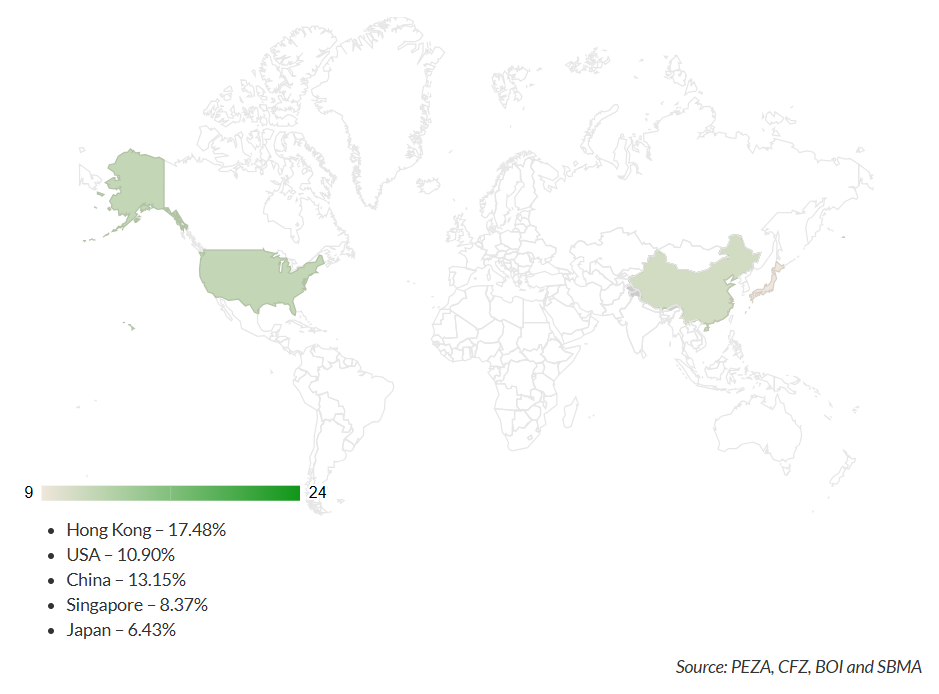About the Industry
The Philippine Electronics Industry is classified into 73% Semiconductor Manufacturing Services (SMS) and 27% Electronics Manufacturing Services (EMS). Most of the electronics businesses in the country operate in four key areas: Metro Manila, CALABARZON, Northern/Central Luzon and Cebu. Electronic companies in the country practice the best known methods in manufacturing with capabilities ranging from IC packaging, PCB Assembly and Full Product Assembly.
As of April 2023 year-to-date, cumulative electronics exports reached US$ 12.90 billion, or 59.28% of the total Philippine exports. Moreover, 17.48% of the country’s electronics exports went to Hong Kong, followed by China (13.15%), the USA (10.90%), Singapore (8.37%) and Japan (6.43%), which complete the top five exports destination of the electronics sector.
1. Critical Mass of Global Players
a. Majority of the electronics companies are located in Metro Manila, Calabarzon, Northern/Central Luzon and Cebu.
2. People/Filipino Workers
a. Highly competitive, English-proficient and skilled workers
b. Trainable (8 weeks/2 months), adept at technology, and short learning curves
c. Wide talent pool as there are about 500,000 who graduate yearly
3. Strategic Location
a. Located within 4-hour flying time from major capitals within the region
b. A critical entry point to over 500 million people in the ASEAN marke
c. A gateway of international shipping and air lanes suited for European and American businesses
1. SMS – 73%
a. Components/Devices (Semiconductor)
2. EMS – 27%
a. Computer Related Products/EDP
b. Office Equipment
c. Consumer Electronics
d. Telecommunication
e. Communication/Radar
f. Control & Instrumentation
g. Medical/Industrial Instrumentation
h. Automotive Electronics
i. Solar/PV

• ISO Certified
• Practices the Best Known Methods in Manufacturing (JIT,TQM, 5S, GJ, BSC, QPIC)
• Capabilities Range from IC Packaging, PCB Assembly, Full Product Assembly
• In-house Training Capability
• Runs at 3 Shifts a Day/Compressed WW
• Better Compensation Package
• Non-Unionized with Low Turnover
• Located in Economic Zone or BOI Registered
• Operates with clean rooms and fully integrated manufacturing facilities
• R&D Capability
PH Electronics Exports (Year-to-Date) 

In spite of the decline % share in total exports. The electronics industry remains to be a great contributor to the Philippine economy in terms of:
a. If the electronics industry ceases to produce output, purchase inputs and distribute its products, GDP will drop by 28%
b. P1 increase in export sales generate at least 0.12 cents additional indirect taxes in the economy. In 2012, the industry’s total direct tax contribution was about US$690 million
c. P1 billion increase in investments create about 620 to 1,408 additional quality jobs in the economy
d. A P1 increase in export sales generate 0.11 cents to 0.25 cents additional household income in the economy
e. US$1 billion of investments create US$10.5 billion of exports from 2010 to 2012.
|
Impact of the Hypothetical Loss of Selected Industries on Gross Domestic Product |
% Drop in GDP |
The semiconductor and electronics still has the highest % impact on the country’s Gross Domestic Product.
|
Private Services |
12.1% |
|
Agriculture, Forestry and Fishery |
14.9% |
|
Semiconductor and electronics industry |
28% |



